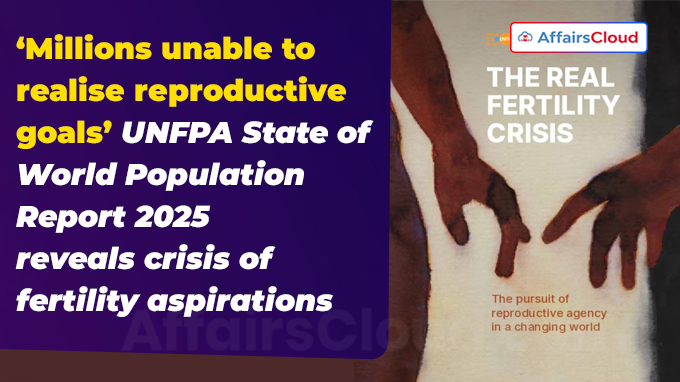 In June 2025, New York, the United States of America(USA) based United Nations Population Fund (UNFPA) released its State of World Population (SOWP) Report 2025 titled “The Real Fertility Crisis : The pursuit of reproductive agency in a changing world”, spotlighting major barriers preventing people globally, including in India, from achieving their reproductive aspirations.
In June 2025, New York, the United States of America(USA) based United Nations Population Fund (UNFPA) released its State of World Population (SOWP) Report 2025 titled “The Real Fertility Crisis : The pursuit of reproductive agency in a changing world”, spotlighting major barriers preventing people globally, including in India, from achieving their reproductive aspirations.
- The report finds that 1 in 5 people globally expect not to have the number of children that they desire due to the prohibitive cost of parenthood, job insecurity, housing, and other concerns.
- The report highlighted that there is a shift from panic over falling fertility to addressing unmet reproductive goals.
About State of World Population (SOWP) Report :
i.The UNFPA publishes the SOWP report annually. This flagship publication provides an in-depth analysis of global population trends, focusing on the interplay between demographic changes and human rights, particularly reproductive rights.
ii.The reports analyze shifts in fertility rates, life expectancy, and migration patterns, exploring their implications for economic development, healthcare systems, and social structures.
iii.The 2025 SOWP report, based on a YouGov survey in 14 countries including India, Brazil, Morocco, South Africa, Indonesia, Mexico, Nigeria, Italy, Thailand, Hungary, United States of America(USA), Sweden, Republic of Korea and Germany.
- The survey covered a diverse group of low-, middle-, and high-income countries, representing both low and high fertility contexts. Respondents included both young adults and individuals who were beyond their reproductive years.
- The survey is a pilot for research in 50 countries later this year.
Key highlights of the report:
i.The SOWP 2025 underlines that the real crisis is not under-population or over-population but the millions of individuals who are unable to realise their real fertility goals.
ii.An online poll with 14,000 respondents was conducted and it was found that there were multiple barriers to reproductive autonomy in India:
- Financial limitations: Job insecurity (21%), housing constraints (22%), and the lack of reliable childcare (18%) make parenthood feel out of reach.
- Health Barriers: Poor general well-being (15%), infertility (13%), and limited access to pregnancy-related care (14%) add further strain.1 in 4 individuals reported being unable to have a child at their preferred time, reflecting unmet reproductive aspirations.
- Future Anxiety: Unexpected climate change, political and social instability.
- Family Pressure: 19% faced partner or family pressure to have fewer children than they personally wanted.
iii.Since 1950, the global population has more than tripled, while the average fertility rate per woman has dropped from 5.0 to 2.25. Projections indicate it will further decline to the replacement level of 2.1 by 2050.
Implications for India:
i.The report classifies India among middle-income nations experiencing swift demographic transitions, noting that the country’s population doubling time is now projected at 79 years.
ii.As per the report, 1 in 3 adult Indians (36%) face unintended pregnancies, while 30% experience unfulfilled desire for having either more or fewer children and 23% faced both.
iii.The report highlights that 51% of Indian women aged 15–49 years use some form of contraception, with a higher prevalence of 68% among married women. Among respondents, 41% of women identified two children as the ideal family size, while 12% preferred having more than two children.
iii.Though India may have reached replacement-level fertility of 2.0, many people still face significant barriers to making free and informed decisions about their reproductive lives and significant disparities persist across regions and states.
- The UN report aligns with the findings of National Family Health Survey (NFHS-5), reinforcing similar trends in fertility and reproductive health indicators.
iv.Fertility has fallen below the replacement level (2.1) in 31 states/UTs, but remains high in Bihar (3.0), Meghalaya (2.9), and Uttar Pradesh, UP (2.7).
- Urban-rural gaps persist, and seven states have yet to reach replacement Total Fertility Rate (TFR) in rural areas.
- In Tamil Nadu(TN), Kerala, and Delhi, many couples delay or skip childbirth due to costs and work-life conflict, especially among educated middle-class women.
v.The UNFPA’s vision for India is “Demographic resilient society” i.e. ability to adapt to population change without sacrificing human rights.
Limited infertility services in public sector:
i.As per the report, infertility is under-prioritised in India and needs to be considered for inclusion under the government’s health insurance schemes.
- Despite an estimated 27.5 million Indian couples experiencing infertility, public healthcare services remain inadequate.
ii.On the other hand, the Private sector services being unreachable for everyone due to its high expense and concentration in urban centres primarily.
Important Terms:
- Replacement Fertility Rate: It is the rate at which a population size remains the same from one generation to the next
- Total Fertility Rate: It is the average number of children a woman will have in her lifetime.
About United Nations Population Fund (UNFPA):
UNFPA is formally named the United Nations Population Fund. It is a subsidiary organ of the UN General Assembly(UNGA), reports to the UNDP/UNFPA Executive Board of 36 UN Member States and receives overall policy guidance from the UN Economic and Social Council (ECOSOC).
Executive Director(ED) – Natalia Kanem
Headquarters – New York, the United States of America(USA)
Established – 1969




